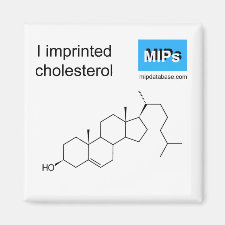
Authors: Cheng Y, Jiang P, Lin S, Li YN, Dong XC
Article Title: An imprinted fluorescent chemosensor prepared using dansyl-modified β-cyclodextrin as the functional monomer for sensing of cholesterol with tailor-made selectivity.
Publication date: 2014
Journal: Sensors and Actuators B: Chemical
Volume: 193
Page numbers: 838-843.
DOI: 10.1016/j.snb.2013.12.039
Alternative URL: http://www.sciencedirect.com/science/article/pii/S0925400513015128
Abstract: A novel cholesterol-imprinted fluorescent chemosensor was synthesized by molecular imprinting technique. In the molecular imprinting, dansyl-modified β-cyclodextrin (β-CD-en-DNS) was used as the functional monomer that formed a complex with cholesterol by inclusion interactions. The membrane chemosensor responded to the addition of cholesterol via a "turn off" mode. The chemosensor has selectivity for cholesterol, which differs from that of the monomer β-CD-en-DNS. This tailor-made response of the chemosensor demonstrated that imprinted binding sites were formed. The 2D 1H NMR experiment indicated that one cholesterol molecule interacted with two β-CDs to form binding receptors for the analyte. In the present study, the fluorescence change of dansyl groups with the variation of the environment due to the in-out of the CD cavity was utilized to signal the binding of the analytes. This sensing mechanism can be utilized by the compounds which have inclusion interaction with β-CD. It provided more applications in the fabrication of imprinted fluorescent chemosensors by molecular imprinting technique. Meanwhile, because β-CD is water soluble and can include neutral compounds, this imprinted chemosensor has advantage in the recognition of organic analytes in the aqueous solution
Template and target information: cholesterol
Author keywords: molecular imprinted membrane, Dansyl-modified cyclodextrin, fluorescent chemosensor, cholesterol



Join the Society for Molecular Imprinting

New items RSS feed
Sign-up for e-mail updates:
Choose between receiving an occasional newsletter or more frequent e-mail alerts.
Click here to go to the sign-up page.
Is your name elemental or peptidic? Enter your name and find out by clicking either of the buttons below!
Other products you may like:
 MIPdatabase
MIPdatabase









